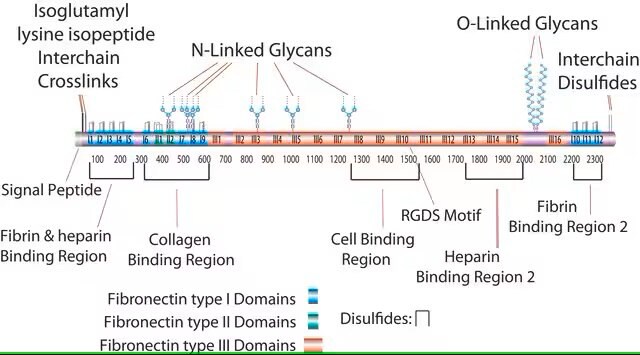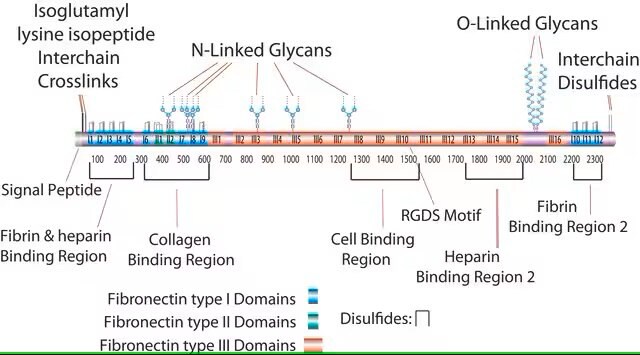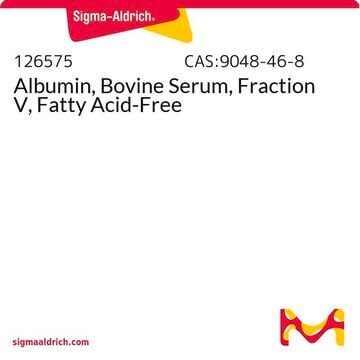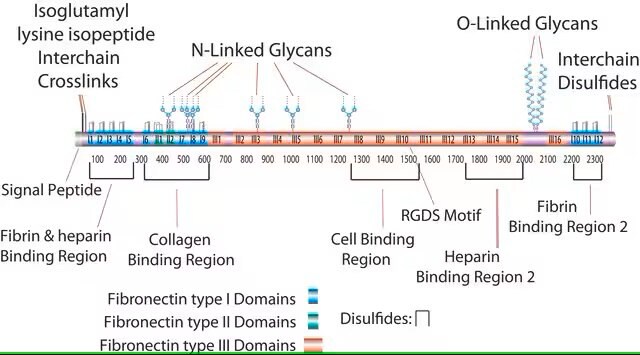We test the coated culture surface by culturing cells. We compare the adherence of the cells to wells that have been coated with media containing BSA (negative) and media containing 10% FBS (positive). The cell growth should be not less than 50% of the positive control and greater than 50% of the negative control.
F2006
Human Fibronectin
from human plasma, powder, suitable for cell culture
Sinonimo/i:
Fibronectina
Scegli un formato
Scegli un formato
About This Item
Prodotti consigliati
Nome del prodotto
Fibronectina da plasma umano, lyophilized powder, BioReagent, suitable for cell culture
Origine biologica
human plasma
Livello qualitativo
Sterilità
sterile
Nome Commerciale
BioReagent
Saggio
≥85% (SDS-PAGE)
Stato
lyophilized powder
PM
450 kDa
Confezionamento
pkg of 5 x 5 mg
pkg of 1 mg
pkg of 2 mg
pkg of 5 mg
Concentrazione
>1 mg/mL protein
tecniche
cell culture | mammalian: suitable
Copertura della superficie
1‑5 μg/cm2
Impurezze
HBSAG, none detected
HCV, none detected
HIV-1/HIV-2, none detected
Solubilità
H2O: 1 mg/mL at 37 °C (Store reconstituted solution in working aliquots at -20°C or lower.)
N° accesso NCBI
N° accesso UniProt
Specificità del legame
Peptide Source: Collagen
Condizioni di spedizione
dry ice
Temperatura di conservazione
−20°C
Informazioni sul gene
human ... FN1(2335)
Cerchi prodotti simili? Visita Guida al confronto tra prodotti
Descrizione generale
Applicazioni
- semina di cellule e differenziamento neuronale (come uno dei componenti nel terreno di espansione per la risospensione di cellule staminali del sangue del cordone ombelicale, o CBCS, usata anche come componente del terreno di differenziamento)[3]
- colture cellulari (la camera di coltura è stata rivestita con fibronectina per favorire l′espressione di cellule HEK293[4]
- saggi di pulldown in vitro della fibronectina (FN) [5]
- studi di specificità proteica[6]
- studi sulla migrazione cellulare[7]
Azioni biochim/fisiol
Avvertenza
Nota sulla preparazione
Esclusione di responsabilità
Codice della classe di stoccaggio
11 - Combustible Solids
Classe di pericolosità dell'acqua (WGK)
WGK 3
Punto d’infiammabilità (°F)
Not applicable
Punto d’infiammabilità (°C)
Not applicable
Dispositivi di protezione individuale
Eyeshields, Gloves, type N95 (US)
Scegli una delle versioni più recenti:
Certificati d'analisi (COA)
Non trovi la versione di tuo interesse?
Se hai bisogno di una versione specifica, puoi cercare il certificato tramite il numero di lotto.
Possiedi già questo prodotto?
I documenti relativi ai prodotti acquistati recentemente sono disponibili nell’Archivio dei documenti.
I clienti hanno visto anche
Articoli
Fibronectin (FN) plays crucial roles in extracellular matrix fibril assembly and cellular interactions.
The extracellular matrix (ECM) and its attachment factor components are discussed in this article in relation to their function in structural biology and their availability for in vitro applications.
The extracellular matrix (ECM) is secreted by cells and surrounds them in tissues.
3D cell culture overview. Learn about 2D vs 3D cell culture, advantages of 3D cell culture, and techniques available to develop 3D cell models
Protocolli
Dilute fibronectin for cell attachment, varying per cell type. Coating protocol, products, and FAQs provided.
Contenuto correlato
Defined culture conditions. Consistent growth of human cancer cell lines in PromoCell’s serum-free/xeno-free Cancer Cell Line Media-XF. Explore over 350 PromoCell products on Sigma.com
-
How do I test the wells/flasks that have been coated with fibronectin?
1 answer-
Helpful?
-
-
How do I determine how much fibronectin is in solution?
1 answer-
As the product may contain undissolved material, the amount of fibronectin in solution can be determined by UV absorbance. The extinction coefficient for a 1% solution (10 mg/ml) is 13.5 at 280 nm.
Helpful?
-
-
What is the procedure for coating culture surfaces with fibronectin?
1 answer-
To coat culture surfaces: 1. Dilute fibronectin in sterile balanced salt solution and coat the culture surface (1-5 μg/cm2) with a minimal volume. 2. Allow to air dry for at least 45 minutes at room temperature. Excess fibronectin may be removed by aspiration, but this is not necessary.
Helpful?
-
-
How do I solubilized Fibronectin?
1 answer-
Dissolve at 1 mg/mL in water. Allow to dissolve for at least 30 minutes at 37 °C. A small amount of undissolved material may remain. This will not affect product performance.
Helpful?
-
-
How do I choose which fibronectin product to use to coat culture surfaces for cell growth?
1 answer-
The species source for the fibronectin used when coating culture surfaces is not important. It is the presence of the RGD binding site that is present in all fibronectins that promotes binding.
Helpful?
-
-
How long can I store fibronectin coated plates, etc?
1 answer-
Fibronectin coated cultureware can be stored for 2-4 weeks at 2-8 °C in a closed sterile container, or in sterile sealable bags.
Helpful?
-
-
What is the difference between Fibronection Products F2006 and F1056?
1 answer-
The difference between Product Nos. F2006 and F1056 is in the purity specifications and endotoxin testing. Product No. F2006 has a purity specification of ≥90% and is not tested for endotoxin contamination. Product No. F1056 has a purity specification of ≥95% and is tested for endotoxin contamination with a specification of ≤100 EU/mg.
Helpful?
-
-
How long can I store the fibronectin solution?
1 answer-
The product is good for at least a year at 2-8 °C if kept sterile.
Helpful?
-
-
What is the Department of Transportation shipping information for this product?
1 answer-
Transportation information can be found in Section 14 of the product's (M)SDS.To access the shipping information for this material, use the link on the product detail page for the product.
Helpful?
-
Active Filters
Il team dei nostri ricercatori vanta grande esperienza in tutte le aree della ricerca quali Life Science, scienza dei materiali, sintesi chimica, cromatografia, discipline analitiche, ecc..
Contatta l'Assistenza Tecnica.









